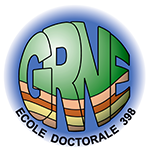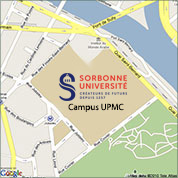Séminaire ISTeP - Audrey Ougier-Simonin
(ISTerre, Grenoble)
Effet de la pression de pore sur la propagation des fractures et les instabilités de glissement: Un mécanisme possible pour les séismes lents ?
Slow slips phenomena, including non-volcanic tremors, episodic tremor and slips, low to very low frequency earthquakes, observed in various convergent margins are the most exciting discovery in seismology in the last decade. But, to date, the deformation mechanisms associated with slow events are unknown. High pore pressure is widely cited to be associated with slow slip events. However, high pore pressure is also known to induce small magnitude seismic events (not slow slip events) near reservoirs or at the waste water injection sites. Pore fluid pressure and shear rupture are known to be interwoven but at what conditions that high pore pressure induces slow slip events remains speculative.
Triaxial deformation experiments were conducted to investigate the effect of excess pore pressure on brittleness and slowness of shear rupture propagation in porous saturated rocks. Using the existing theoretical framework (bifurcation model, slip weakening model), we calculate the slip rate and shear fracture energy during faulting and quantify the differences in slip behavior.
Our results show that along a creeping fault where dynamic rupture is inhibited (transitional regime), increasing pore pressure can induce slip instability. The slip rate, shear stress drop and fracture energy during the slip event resembles those of slow earthquakes. Microstructural observations highlight that increasing pore pressure allows overcoming the dilatancy strengthening effect in these conditions. This study provides experimental evidence that: 1) there may exists a continuous spectrum of slip rate and energy budget between ordinary earthquake (rapid slip) and slow slip phenomena, 2) such slow slip behavior can be triggered by excess pore pressure at the brittle-ductile transition, and 3) near-lithostatic pore pressure is not always necessary for inducing slow slip events.
05/02/2014 à 12h30, Salle Fourcade (Tour 55-56, 4ème étage)
Egalement dans la rubrique
Chiffres clés (Mars 2025)
L'ISTeP comprend 131 membres dont :
Permanents (66)
- Professeurs : 17 (+2 PAST)
- Maîtres de conférence : 26
- Directeurs de recherche CNRS : 1
- Chargés de recherche CNRS : 1
- ITA : 19
Personnels non permanents (65)
- Collaborateurs bénévoles / émérites : 17
- Chaire de professeur junior : 1
- Enseignants-chercheurs contractuel : 2
- 1 MCF accueil en délégation
- ATER et Post-Docs : 9
- Doctorants : 32
- ITA-BIATSS : 3





